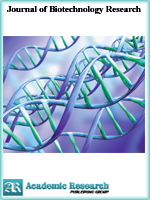Journal of Biotechnology Research
Online ISSN: 2413-3256
Print ISSN: 2413-8878
Print ISSN: 2413-8878
Quarterly Published (4 Issues Per Year)

Archives
Volume 3 Number 4 April 2017
Evaluation of Incidence and Outcome of Spontaneous Bacterial Peritonitis in Cirrhotic Patients with Ascites in East Indian Population
Authors: Ranbeer kumar Singh ; Dipak kushwaha ; Amitesh Kumar ; S.S.Haque ; Md.Tanweeruddin ; Tarique Aziz
Pages: 25-30
Abstract
Background: Spontaneous bacterial peritonitis (SBP) is the most common infection of ascitic fluid that occurs in patients with cirrhotic ascites typically described in hospitalized patients. Objectives: To determine the prevalence, incidence and outcome of spontaneous bacterial peritonitis in adult patients with liver cirrhosis and ascites admitted at Narayam Medical College and Hospital, Jamuhar, Sasaram, Bihar. Materials and methods: A study was conducted involving 60 patients with liver cirrhosis and ascites between October 2013 and April 2014. Ascitic fluid culture, the gold standard for SBP diagnosis was done, for culture positive results susceptibility testing of common antibiotics using a disc diffusion method was done. Ascitic fluid cell count and bedside dipstick test were also done. Positive ascitic fluid culture, ascitic PMNs ≥250cells/μL and positive dipstick test were diagnostic for SBP. Results: Out of 60 cases of Cirrhosis of liver, 43 (71.73%) patients were identified as cirrhotics of alcoholic etiology and 17 (28.26%) patients as cirrhotics of non- alcoholic etiology The incidence of SBP in Cirrhosis of Liver was 13 (20.65%) out of 60 patients in which 11(89.47 %) were male patients while 2 (10.25%) were female patients, showing that incidence of SBP is more in males compared to females. Out of total 13 cases of SBP, 10 (78.94%) cases were culture Positive Neutrocytic Ascites and 3 (21.05%) cases were culture Negative Neutrocytic Ascites, and out of 10 cases of culture positive neutrocytic ascites, 1 organism was isolated in 7 (73.33%) cases. Two organisms in 2 (20.00%) cases and 3 organisms in 1 (6.66%) cases indicating that incidence of monomicrobial neutrocytic ascites was highest ,seen in 7 (73.33%) cases compared to polymicrobial neutrocytic ascites ,which was least seen in 1 (6.66%) case. Out of 13 cases of SBP, death occurred in 5 (38%) cases and 8(62%) patients survive . Conclusion: Alcoholic cirrhosis is important contributing factor of SBP with liver cirrhosis than in non-alcoholic etiology. Therefore early recognition and prompt treatment of SBP can significantly reduce the mortality and morbidity of patients associated with decompensated cirrhosis of liver of alcoholic etiology and non alcoholic etiology.



